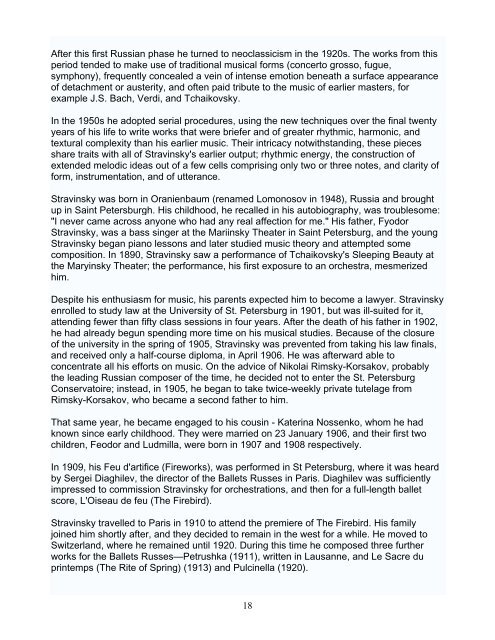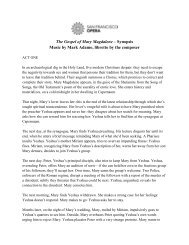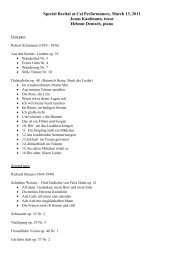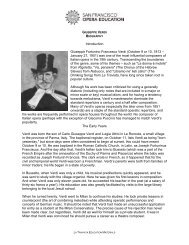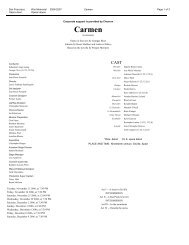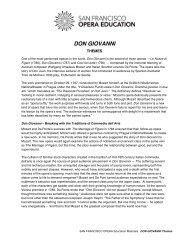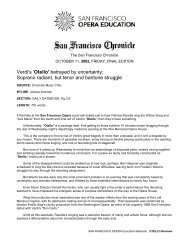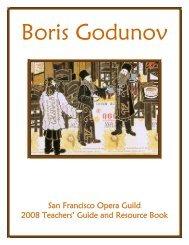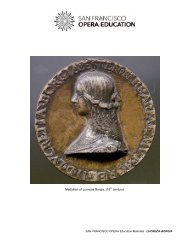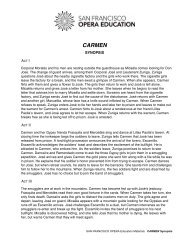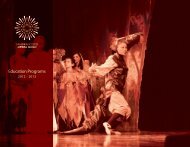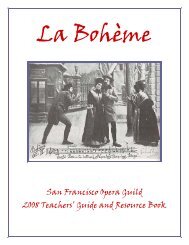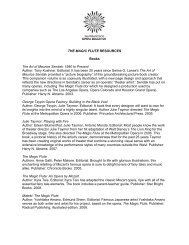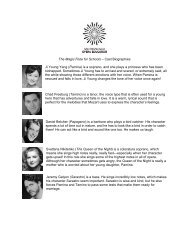The Rake's Progress Teachers Guide - San Francisco Opera
The Rake's Progress Teachers Guide - San Francisco Opera
The Rake's Progress Teachers Guide - San Francisco Opera
Create successful ePaper yourself
Turn your PDF publications into a flip-book with our unique Google optimized e-Paper software.
After this first Russian phase he turned to neoclassicism in the 1920s. <strong>The</strong> works from this<br />
period tended to make use of traditional musical forms (concerto grosso, fugue,<br />
symphony), frequently concealed a vein of intense emotion beneath a surface appearance<br />
of detachment or austerity, and often paid tribute to the music of earlier masters, for<br />
example J.S. Bach, Verdi, and Tchaikovsky.<br />
In the 1950s he adopted serial procedures, using the new techniques over the final twenty<br />
years of his life to write works that were briefer and of greater rhythmic, harmonic, and<br />
textural complexity than his earlier music. <strong>The</strong>ir intricacy notwithstanding, these pieces<br />
share traits with all of Stravinsky's earlier output; rhythmic energy, the construction of<br />
extended melodic ideas out of a few cells comprising only two or three notes, and clarity of<br />
form, instrumentation, and of utterance.<br />
Stravinsky was born in Oranienbaum (renamed Lomonosov in 1948), Russia and brought<br />
up in Saint Petersburgh. His childhood, he recalled in his autobiography, was troublesome:<br />
"I never came across anyone who had any real affection for me." His father, Fyodor<br />
Stravinsky, was a bass singer at the Mariinsky <strong>The</strong>ater in Saint Petersburg, and the young<br />
Stravinsky began piano lessons and later studied music theory and attempted some<br />
composition. In 1890, Stravinsky saw a performance of Tchaikovsky's Sleeping Beauty at<br />
the Maryinsky <strong>The</strong>ater; the performance, his first exposure to an orchestra, mesmerized<br />
him.<br />
Despite his enthusiasm for music, his parents expected him to become a lawyer. Stravinsky<br />
enrolled to study law at the University of St. Petersburg in 1901, but was ill-suited for it,<br />
attending fewer than fifty class sessions in four years. After the death of his father in 1902,<br />
he had already begun spending more time on his musical studies. Because of the closure<br />
of the university in the spring of 1905, Stravinsky was prevented from taking his law finals,<br />
and received only a half-course diploma, in April 1906. He was afterward able to<br />
concentrate all his efforts on music. On the advice of Nikolai Rimsky-Korsakov, probably<br />
the leading Russian composer of the time, he decided not to enter the St. Petersburg<br />
Conservatoire; instead, in 1905, he began to take twice-weekly private tutelage from<br />
Rimsky-Korsakov, who became a second father to him.<br />
That same year, he became engaged to his cousin - Katerina Nossenko, whom he had<br />
known since early childhood. <strong>The</strong>y were married on 23 January 1906, and their first two<br />
children, Feodor and Ludmilla, were born in 1907 and 1908 respectively.<br />
In 1909, his Feu d'artifice (Fireworks), was performed in St Petersburg, where it was heard<br />
by Sergei Diaghilev, the director of the Ballets Russes in Paris. Diaghilev was sufficiently<br />
impressed to commission Stravinsky for orchestrations, and then for a full-length ballet<br />
score, L'Oiseau de feu (<strong>The</strong> Firebird).<br />
Stravinsky travelled to Paris in 1910 to attend the premiere of <strong>The</strong> Firebird. His family<br />
joined him shortly after, and they decided to remain in the west for a while. He moved to<br />
Switzerland, where he remained until 1920. During this time he composed three further<br />
works for the Ballets Russes—Petrushka (1911), written in Lausanne, and Le Sacre du<br />
printemps (<strong>The</strong> Rite of Spring) (1913) and Pulcinella (1920).<br />
18


